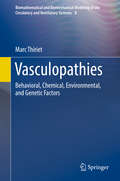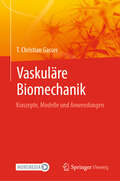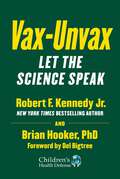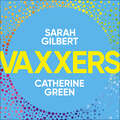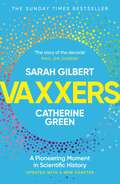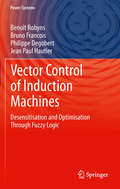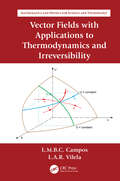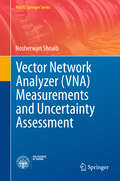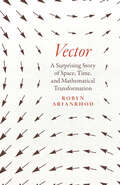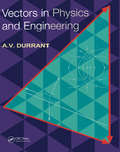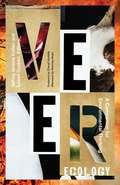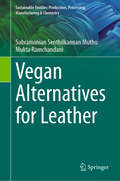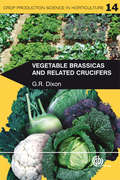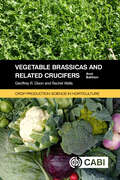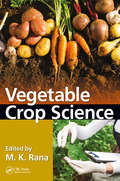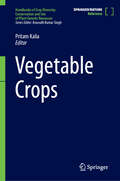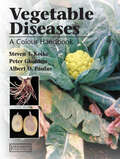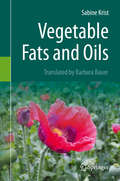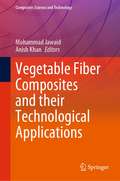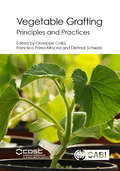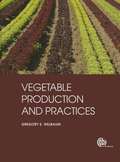- Table View
- List View
Vasculopathies: Behavioral, Chemical, Environmental, and Genetic Factors (Biomathematical and Biomechanical Modeling of the Circulatory and Ventilatory Systems #8)
by Marc ThirietThis volume presents one of the clinical foundations of vasculopathies: the biological markers and risk factors associated with cardiovascular disease. A detailed biological and clinical framework is provided as a prerequisite for adequate modeling. Chapter 1 presents cardiovascular risk factors and markers, where the search for new criteria is aimed at improving early detection of chronic diseases. The subsequent chapters focus on hypertension, which involves the kidney among other organs as well as many agents, hyperglycemia and diabetes, hyperlipidemias and obesity, and behavior. The last of these risk factors includes altered circadian rhythm, tobacco and alcohol consumption, physical inactivity, and diet. The volumes in this series present all of the data needed at various length scales for a multidisciplinary approach to modeling and simulation of flows in the cardiovascular and ventilatory systems, especially multiscale modeling and coupled simulations. The cardiovascular and respiratory systems are tightly coupled, as their primary function is to supply oxygen to and remove carbon dioxide from the body's cells. Because physiological conduits have deformable and reactive walls, macroscopic flow behavior and prediction must be coupled to nano- and microscopic events in a corrector scheme of regulated mechanisms. Therefore, investigation of flows of blood and air in anatomical conduits requires an understanding of the biology, chemistry, and physics of these systems together with the mathematical tools to describe their functioning in quantitative terms.
Vaskuläre Biomechanik: Konzepte, Modelle und Anwendungen
by T. Christian GasserDieses Lehrbuch dient als moderne Einführung in die vaskuläre Biomechanik und bietet den umfassenden Überblick über das gesamte Gefäßsystem, der für die Durchführung erfolgreicher vaskulärer biomechanischer Simulationen erforderlich ist. Es zielt darauf ab, dem Leser eine ganzheitliche Analyse des Gefäßsystems in Richtung seiner biomechanischen Beschreibung zu vermitteln und enthält zahlreiche vollständig durchgerechnete Beispiele. Zu den verschiedenen behandelten Themen gehören die Beschreibung des Gefäßsystems, der Gefäßaustausch, die Mechanik der Blutgefäße, die Charakterisierung des Gefäßgewebes, die Mechanik des Blutflusses sowie das Wachstum und der Umbau des Gefäßgewebes.Dieses Lehrbuch ist ideal geeignet für Studenten und Forscher, die sich mit klassischer und rechnerischer vaskulärer Biomechanik beschäftigen. Das Buch könnte auch für Entwickler von vaskulären Geräten und für Experten, die sich mit der Zulassung biomedizinischer Simulationen befassen, von Interesse sein.Folgt dem Prinzip des "learning by doing" und bietet zahlreiche vollständig durchgerechnete Beispiele für aktives Lernen, sofortiges Erinnern und Selbstüberprüfung;Vermittelt ein ganzheitliches Verständnis der Funktionsweise von Gefäßen und die Integration von Informationen aus verschiedenen Disziplinen, um die Studierenden in die Lage zu versetzen, anspruchsvolle numerische Methoden zur Simulation der Reaktion des Gefäßsystems einzusetzen;Enthält mehrere Fallstudien, die das vorgestellte Material integrieren. Die Fallstudien befassen sich mit Problemen wie der biomechanischen Bewertung des Rupturrisikos von Bauchaortenaneurysmen, der Finite-Elemente-Analyse von Struktur- und Blutflussproblemen sowie der Berechnung von Wandspannung und Wandschubspannung in der Aorta.
Vaulting Ambition: Sociobiology and the Quest for Human Nature
by Philip KitcherVaulting Ambitionis the first extensive and detailed evaluation of the controversial claims that sociobiologists have made about human nature and human social behavior. It raises the "sociobiology debate" to a new level, moving beyond arguments about the politics of the various parties involved, the degree to which sociobiology assumes genetic determinism, or the falsifiability of the general theory. Sociobiology has made a great deal of noise in the popular intellectual culture. Vaulting Ambition cuts through the charges and counter-charges to take a hard look at the claims and analyses offered by the sociobiologists. It examines what the claims mean, how they relate to standard evolutionary theory, how the biological models are supposed to work, and what is wrong with the headline-grabbing proclamations of human sociobiology. In particular, it refutes the notions that humans are trapped by their evolutionary biology and history in endlessly repeating patterns of aggression, xenophobia, and deceitfulness, or that the inequities of sex, race, and class are genetically based or culturally determined. And it takes up issues of human altruism, freedom, and ethics as well. Kitcher weighs the evidence for sociobiology, for human sociobiology, and for "the pop sociobiological view" of human nature that has engendered the controversy. He concludes that in the field of nonhuman animal studies, rigorous and methodologically sound work about the social lives of insects, birds, and mammals has been done. But in applying the theories to human beings-where even more exacting standards of evidence are called for because of the potential social disaster inherent in adopting a working hypothesis as a basis for public policy - many of the same scientists become wildly speculative, building grand conclusions from what Kitcher shows to be shoddy analysis and flimsy argument. While it may be possible to develop a genuine science of human behavior based on evolutionary biology, genetics, cognition, and culture, Kitcher points out that the sociobiology that has been loudly advertised in the popular and intellectual press is not it. Pop sociobiology has in fact been felled by its overambitious and overreaching creators.
Vax-Unvax: Let the Science Speak (Children’s Health Defense)
by Brian Hooker Robert F. Kennedy Jr.The Studies the CDC Refuses to Do This book is based on over one hundred studies in the peer-reviewed literature that consider vaccinated versus unvaccinated populations. Each study is analyzed, and health differences among infants, children, and adults who have been vaccinated and those who have not are presented and put in context. Readers will find information on: The infant/child vaccination schedule Thimerosal in vaccines Live virus vaccines The human papillomavirus (HPV) vaccine Vaccination and Gulf War illness Influenza (flu) vaccines Hepatitis B vaccination The COVID-19 vaccine Vaccines during pregnancy Given the massive push to vaccinate the entire global population, this book is timely and necessary for individuals to make informed choices for themselves and their families.
Vaxxers: A Pioneering Moment in Scientific History
by Sarah Gilbert Catherine Green*The inside story of the Oxford AstraZeneca vaccine, from two of the leading scientists who created it. Fully updated for paperback publication with a preface and a new chapter .*This is the story of a race - not against other vaccines or other scientists, but against a deadly and devastating virus. On 1 January 2020, Sarah Gilbert, Professor of Vaccinology at Oxford University, read an article about four people in China with a strange pneumonia. Within two weeks, she and her team had designed a vaccine against a pathogen that no one had ever seen before. Less than 12 months later, vaccination was rolled out across the world to save millions of lives from Covid-19. In Vaxxers, we hear directly from Professor Gilbert and her colleague Dr Catherine Green as they reveal the inside story of making the Oxford AstraZeneca vaccine and the cutting-edge science and sheer hard work behind it. This is their story of fighting a pandemic as ordinary people in extraordinary circumstances. Sarah and Cath share the heart-stopping moments in the eye of the storm; they separate fact from fiction; they explain how they made a safe vaccine in record time with the eyes of the world watching; and they give us hope for the future. Vaxxers invites us into the lab to find out how science will save us from this pandemic, and how we can prepare for the inevitable next one.(P) 2021 Hodder & Stoughton Ltd
Vaxxers: The Inside Story of the Oxford AstraZeneca Vaccine and the Race Against the Virus
by Sarah Gilbert Catherine GreenTHE SUNDAY TIMES BESTSELLER*Radio 4 Book of the Week*This is the story of a race - not against other vaccines or other scientists, but against a deadly and devastating virus.On 1 January 2020, Sarah Gilbert, Professor of Vaccinology at Oxford University, read an article about four people in China with a strange pneumonia. Within two weeks, she and her team had designed a vaccine against a pathogen that no one had ever seen before. Less than 12 months later, vaccination was rolled out across the world to save millions of lives from Covid-19.In Vaxxers, we hear directly from Professor Gilbert and her colleague Dr Catherine Green as they reveal the inside story of making the Oxford AstraZeneca vaccine and the cutting-edge science and sheer hard work behind it. This is their story of fighting a pandemic as ordinary people in extraordinary circumstances. Sarah and Cath share the heart-stopping moments in the eye of the storm; they separate fact from fiction; they explain how they made a highly effective vaccine in record time with the eyes of the world watching; and they give us hope for the future.Vaxxers invites us into the lab to find out how science will save us from this pandemic, and how we can prepare for the inevitable next one.
Vaxxers: The Inside Story of the Oxford AstraZeneca Vaccine and the Race Against the Virus
by Sarah Gilbert Catherine GreenTHE SUNDAY TIMES BESTSELLER*Radio 4 Book of the Week*This is the story of a race - not against other vaccines or other scientists, but against a deadly and devastating virus.On 1 January 2020, Sarah Gilbert, Professor of Vaccinology at Oxford University, read an article about four people in China with a strange pneumonia. Within two weeks, she and her team had designed a vaccine against a pathogen that no one had ever seen before. Less than 12 months later, vaccination was rolled out across the world to save millions of lives from Covid-19.In Vaxxers, we hear directly from Professor Gilbert and her colleague Dr Catherine Green as they reveal the inside story of making the Oxford AstraZeneca vaccine and the cutting-edge science and sheer hard work behind it. This is their story of fighting a pandemic as ordinary people in extraordinary circumstances. Sarah and Cath share the heart-stopping moments in the eye of the storm; they separate fact from fiction; they explain how they made a highly effective vaccine in record time with the eyes of the world watching; and they give us hope for the future.Vaxxers invites us into the lab to find out how science will save us from this pandemic, and how we can prepare for the inevitable next one.
Vector Biology, Ecology and Control
by Peter W. AtkinsonThe control of mosquitoes and other insect vectors of human pathogens in an area-wide, environmentally and sustainable way is critical to solving global health problems in the developing world but also to industrialized countries that already have in place efficient vector control programs. The rapid spread of West Nile virus through the United States provides one example of how even a highly developed country can be relatively powerless against the spread of mosquito-borne disease. This volume illustrates how the efforts over half a century of a single investigator, Mir S. Mulla, and his students and collaborators have achieved sustainable vector insect control in regions of the world extending from the south-western United States to south-east Asia. These control strategies have been refined over these decades and now are employed in a diversity of ecosystems. Increased public awareness of global health and the importance placed on this for the future well-being of the entire human population makes the deployment and refinement of these strategies even more timely.
Vector Control of Induction Machines
by Bruno Francois Philippe Degobert Benoît Robyns Jean Paul HautierAfter a brief introduction to the main law of physics and fundamental concepts inherent in electromechanical conversion, Vector Control of Induction Machines introduces the standard mathematical models for induction machines - whichever rotor technology is used - as well as several squirrel-cage induction machine vector-control strategies. The use of causal ordering graphs allows systematization of the design stage, as well as standardization of the structure of control devices. Vector Control of Induction Machines suggests a unique approach aimed at reducing parameter sensitivity for vector controls based on a theoretical analysis of this sensitivity. This analysis naturally leads to the introduction of control strategies that are based on the combination of different controls with different robustness properties, through the use of fuzzy logic supervisors. Numerous applications and experiments confirm the validity of this simple solution, which is both reproducible and applicable to other complex systems. Vector Control of Induction Machines is written for researchers and postgraduate students in electrical engineering and motor drive design.
Vector Fields with Applications to Thermodynamics and Irreversibility (Mathematics and Physics for Science and Technology #10)
by Luis Manuel Braga da Costa Campos Luís António Raio VilelaVector Fields with Applications to Thermodynamics and Irreversibility is part of the series "Mathematics and Physics for Science and Technology", which combines rigorous mathematics with general physical principles to model practical engineering systems with a detailed derivation and interpretation of results. Volume V presents the mathematical theory of partial differential equations and methods of solution satisfying initial and boundary conditions, and includes applications to: acoustic, elastic, water, electromagnetic and other waves; the diffusion of heat, mass and electricity; and their interactions. This is the first book of the volume. The second book of volume V continues this book on thermodynamics, focusing on the equation of state and energy transfer processes including adiabatic, isothermal, isobaric and isochoric. These are applied to thermodynamic cycles, like the Carnot, Atkinson, Stirling and Barber-Brayton cycles, that are used in thermal devices, including refrigerators, heat pumps, and piston, jet and rocket engines. In connection with jet propulsion, adiabatic flows and normal and oblique shock waves in free space and nozzles with variable cross-section are considered. The equations of fluid mechanics are derived for compressible two-phase flow in the presence of shear and bulk viscosity, thermal conduction and mass diffusion. The thermodynamic cycles are illustrated by detailed calculations modelling the operation of piston, turbojet and rocket engines in various ambient conditions, ranging from sea level, the atmosphere of the earth at altitude and vacuum of space, for the propulsion of land, sea, air and space vehicles. The book is intended for graduate students and engineers working with mathematical models and can be applied to problems in mechanical, aerospace, electrical and other branches of engineering dealing with advanced technology, and also in the physical sciences and applied mathematics. This book: Simultaneously covers rigorous mathematics, general physical principles and engineering applications with practical interest Provides interpretation of results with the help of illustrations Includes detailed proofs of all results L.M.B.C. Campos was chair professor and the Coordinator of the Scientific Area of Applied and Aerospace Mechanics in the Department of Mechanical Engineering and also the director (and founder) of the Center for Aeronautical and Space Science and Technology until retirement in 2020. L.A.R.Vilela is currently completing an Integrated Master's degree in Aerospace Engineering at Institute Superior Tecnico (1ST) of Lisbon University.
Vector Network Analyzer (VNA) Measurements and Uncertainty Assessment
by Nosherwan ShoaibThis book describes vector network analyzer measurements and uncertainty assessments, particularly in waveguide test-set environments, in order to establish their compatibility to the International System of Units (SI) for accurate and reliable characterization of communication networks. It proposes a fully analytical approach to measurement uncertainty evaluation, while also highlighting the interaction and the linear propagation of different uncertainty sources to compute the final uncertainties associated with the measurements. The book subsequently discusses the dimensional characterization of waveguide standards and the quality of the vector network analyzer (VNA) calibration techniques. The book concludes with an in-depth description of the novel verification artefacts used to assess the performance of the VNAs. It offers a comprehensive reference guide for beginners to experts, in both academia and industry, whose work involves the field of network analysis, instrumentation and measurements.
Vector: A Surprising Story of Space, Time, and Mathematical Transformation
by Robyn ArianrhodA celebration of the seemingly simple idea that allowed us to imagine the world in new dimensions—sparking both controversy and discovery. The stars of this book, vectors and tensors, are unlikely celebrities. If you ever took a physics course, the word “vector” might remind you of the mathematics needed to determine forces on an amusement park ride, a turbine, or a projectile. You might also remember that a vector is a quantity that has magnitude and (this is the key) direction. In fact, vectors are examples of tensors, which can represent even more data. It sounds simple enough—and yet, as award-winning science writer Robyn Arianrhod shows in this riveting story, the idea of a single symbol expressing more than one thing at once was millennia in the making. And without that idea, we wouldn’t have such a deep understanding of our world. Vector and tensor calculus offers an elegant language for expressing the way things behave in space and time, and Arianrhod shows how this enabled physicists and mathematicians to think in a brand-new way. These include James Clerk Maxwell when he ushered in the wireless electromagnetic age; Einstein when he predicted the curving of space-time and the existence of gravitational waves; Paul Dirac, when he created quantum field theory; and Emmy Noether, when she connected mathematical symmetry and the conservation of energy. For it turned out that it’s not just physical quantities and dimensions that vectors and tensors can represent, but other dimensions and other kinds of information, too. This is why physicists and mathematicians can speak of four-dimensional space-time and other higher-dimensional “spaces,” and why you’re likely relying on vectors or tensors whenever you use digital applications such as search engines, GPS, or your mobile phone. In exploring the evolution of vectors and tensors—and introducing the fascinating people who gave them to us—Arianrhod takes readers on an extraordinary, five-thousand-year journey through the human imagination. She shows the genius required to reimagine the world—and how a clever mathematical construct can dramatically change discovery’s direction.
Vectors in Physics and Engineering
by Alan DurrantThis text is an introduction to the use of vectors in a wide range of undergraduate disciplines. It is written specifically to match the level of experience and mathematical qualifications of students entering undergraduate and Higher National programmes and it assumes only a minimum of mathematical background on the part of the reader. Basic mathematics underlying the use of vectors is covered, and the text goes from fundamental concepts up to the level of first-year examination questions in engineering and physics. The material treated includes electromagnetic waves, alternating current, rotating fields, mechanisms, simple harmonic motion and vibrating systems. There are examples and exercises and the book contains many clear diagrams to complement the text. The provision of examples allows the student to become proficient in problem solving and the application of the material to a range of applications from science and engineering demonstrates the versatility of vector algebra as an analytical tool.
Veer Ecology: A Companion for Environmental Thinking
by Jeffrey Jerome Cohen Lowell DuckertThe words most commonly associated with the environmental movement—save, recycle, reuse, protect, regulate, restore—describe what we can do to help the environment, but few suggest how we might transform ourselves to better navigate the sudden turns of the late Anthropocene. Which words can help us to veer conceptually along with drastic environmental flux? Jeffrey Jerome Cohen and Lowell Duckert asked thirty brilliant thinkers to each propose one verb that stresses the forceful potential of inquiry, weather, biomes, apprehensions, and desires to swerve and sheer. Each term is accompanied by a concise essay contextualizing its meaning in times of resource depletion, environmental degradation, and global climate change.Some verbs are closely tied to natural processes: compost, saturate, seep, rain, shade, sediment, vegetate, environ. Many are vaguely unsettling: drown, unmoor, obsolesce, power down, haunt. Others are enigmatic or counterintuitive: curl, globalize, commodify, ape, whirl. And while several verbs pertain to human affect and action—love, represent, behold, wait, try, attune, play, remember, decorate, tend, hope—a primary goal of Veer Ecology is to decenter the human. Indeed, each of the essays speaks to a heightened sense of possibility, awakening our imaginations and inviting us to think the world anew from radically different perspectives. A groundbreaking guide for the twenty-first century, Veer Ecology foregrounds the risks and potentialities of living on—and with—an alarmingly dynamic planet.Contributors: Stacy Alaimo, U of Texas at Arlington; Joseph Campana, Rice U; Holly Dugan, George Washington U; Lara Farina, West Virginia U; Cheryll Glotfelty, U of Nevada, Reno; Anne F. Harris, DePauw U; Tim Ingold, U of Aberdeen; Serenella Iovino, U of Turin; Stephanie LeMenager, U of Oregon; Scott Maisano, U of Massachusetts, Boston; Tobias Menely, U of California, Davis; Steve Mentz, St. John&’s U; J. Allan Mitchell, U of Victoria; Timothy Morton, Rice U; Vin Nardizzi, U of British Columbia; Laura Ogden, Dartmouth College; Serpil Opperman, Hacettepe U, Ankara; Daniel C. Remein, U of Massachusetts, Boston; Margaret Ronda, U of California, Davis; Nicholas Royle, U of Sussex; Catriona Sandilands, York U; Christopher Schaberg, Loyola U; Rebecca R. Scott, U of Missouri; Theresa Shewry, U of California, Santa Barbara; Mick Smith, Queen&’s U; Jesse Oak Taylor, U of Washington; Brian Thill, Golden West College; Coll Thrush, U of British Columbia, Vancouver; Cord J. Whitaker, Wellesley College; Julian Yates, U of Delaware.
Vegan Alternatives for Leather (Sustainable Textiles: Production, Processing, Manufacturing & Chemistry)
by Subramanian Senthilkannan Muthu Mukta RamchandaniEnvironmental toxicity and sustainability are major areas of research for the leather industry, as well as for the larger luxury and fashion industry. Several alternatives to traditional animal-based leather have been introduced in the market as “vegan” leather, e.g. the pineapple skin leather Piñatex, mycelium (mushroom leather), apple leather, cactus leather, and PU/PVC faux leather. However, a clear assessment of the sustainability (e.g. carbon/water footprint, LCA) for these alternatives is missing. The aim of this book is to provide clarity and a coherent structural assessment of sustainable vegan or vegetarian alternatives of leather. This book contributes to the current research within sustainability and environmental impact, production, and consumption aspects of these materials.
Vegetable Brassicas and Related Crucifers
by Geoffrey DixonThe Brassica crops provide the greatest diversity of products derived from a single genus. As vegetables they deliver leaves, flowers, stems and roots that are used either fresh or in processed forms. This book covers the Occidental crops derived from B. oleracea (cole or cabbage group) and Oriental types from B. rapa (Chinese cabbage and its relatives). Both groups are of immense importance for human nutrition, containing vital vitamins and cancer preventing substances.
Vegetable Brassicas and Related Crucifers (Crop Production Science in Horticulture)
by Geoffrey Dixon Dr Rachel WellsThe Brassica genus contains diverse and economically important species and crops, for example, Brassica oleracea including cauliflower to kohlrabi, B.rapa including pak choi to mizuna, and aquatic crucifers such as watercress. These provide humankind with huge diversities of foods, promoting health and well-being. This substantially expanded second edition reflects the significant advances in knowledge of plant breeding and crop production which have occurred since publication of the original book in 2006. Embracing new Brassicaceae research and concepts of sustainable and automated crop production, topics include: Brassica evolution and transcontinental spread as the basis for crop breeding Gene-editing, rapid sequencing, genetic markers and linkage mapping to enable efficient plant breeding Seed development, F1 cultivars and rapid maturing crops for profitable cropping Environmental impacts on pests, pathogens, crop reliability and quality Soil health and fertility as agronomic principles Environmental sustainability, biocontrol and integrated pest management Vegetable brassicas as nutrient-rich foods for optimal health benefits An invaluable resource for all those involved in Brassica production, this is essential reading for researchers and students in horticulture and plant science, growers, producers, consultants and industry advisors.
Vegetable Crop Science
by M. K. RanaThis book has been prepared to provide every production aspect of important vegetables along with information regarding origin and distribution, composition and uses, botany, varieties, climatic and soil requirement, cultivation practices, harvesting, post-harvest management, insect-pests and diseases along with their control measures. Its users would find this book very practical for raising vegetable crops profitably.
Vegetable Crops (Handbooks of Crop Diversity: Conservation and Use of Plant Genetic Resources)
by Pritam KaliaThe volume on Vegetable Crops as a part of series entitled “Handbooks of Crop Diversity: Conservation and Use of Genetic Resources” will be a unique resource, first of its kind, which will elaborate on origin, evolution, taxonomy, identification, chemical characterization, and genetic improvement of Vegetable Crop Plants. Vegetable crops are an important group of crops comprising solanaceous vegetables, Cole crops, Cucurbitaceous crops, Bulb crops, Root crops, Tuber crops, legume vegetables, leafy & salad vegetables, Okra etc. There is tremendous diversity within each group of vegetable crops. This genetic diversity is from the point of view of landraces and varieties of vegetable crops species used for food, processing, nutraceuticals, pharmaceuticals, etc. Vegetables being an integral part of human diet being rich source of diverse nutrients such as vitamins, minerals and antioxidants, they play an important role in balancing the diet and tackling malnutrition. Besides, due to their intensive cultivation, they also play an important role in enhancing per unit area production and productivity, cropping intensity enhancing, thereby, the farmers income, especially that of small and marginal farmers, and providing job opportunities. The genetic improvement of vegetable crops facilitate continued breeding of varieties with greater resilience to stresses and productivity is mainly dependent on overall genetic variation found in individuals belonging to the cultivated species and/or ancestral species related to cultivated species of vegetable crops. Since genes of interest can be tapped from plant sources for their introduction through controlled breeding processes for genetic improvement, and incorporating of desirable external and internal quality traits, therefore accessibility to the information about these plant genetic resources is key to the success of the breeding efforts. Since there is a need of comprehensive information about the genetic resources, therefore it is important to facilitate their conservation and long-term sustainable use in research and improvement. The comprehensive information on the availability of genetic diversity in each vegetable crop species in this volume would facilitate priority conservation in gene banks, research and use in vegetable crop improvement. Realizing the importance of genetic variability in the improvement of vegetable crops from the point of view of biotic and abiotic stress resistance, enhanced micronutrient, climate change, enhanced shelf life, nutraceuticals, bioactive compounds, especially national and international efforts further need to be stepped up for collection, characterization, evaluation, and conservation of vegetable crops genetic resources to facilitate search for new genes, research and their use in vegetable crops improvement. During 21st century, genomics and marker assisted tools have gained importance for hastening the crop improvement programmes by enhancing breeding efficiency. Realizing that population in South Asia and Southeast Asia is facing acute problem of under and malnutrition, the emphasis on dietary diversification with vegetables is therefore being stressed. Besides, to enhance farmers income much emphasis is being laid on development of varieties having diverse maturity, growth habit, resistance to diseases and insect pest to reduce the use pesticides, enhanced nutrients and shelf life. For these traits, we have to look into landraces, and wild relatives for the traits of interest. Therefore, it has been felt to bring out a vegetable volume with additional accessory and supplemental information, analyses and specifically filtered information which can go a long way in promoting research, search for new genes/alleles, revealing the opportunities available for exploitation of PGR in generation of cultivars to meet upcoming challenges of vegetable crop improvement and diversification and requirement of cultivars for processing, nutraceutical and pharma
Vegetable Diseases: A Colour Handbook
by Steven T. Koike Peter Gladders Albert PaulusOur dependence on healthy vegetable crops as a reliable source of food transcends all barriers of nation and culture. Consumers now demand excellent quality from the industry that produces large volumes of high quality vegetables to be sold locally, regionally and shipped internationally. The diseases that affect vegetables compromise such quality
Vegetable Fats and Oils: The Utilisation Of Volatile Compounds In The Characterisation Of Vegetable Oils And Fats And In Reducing The Bacterial Count Of Ambient Air
by Sabine KristThis encyclopedia scientifically describes 121 vegetable oils and fats. In addition to conventional oils, the book also covers lesser-known oils such as Amaranth, Chia, prickly pear, and quinoa. Author pays particular attention to root plants, extraction, and the ingredients included in information nutritionally relevant to fatty acid patterns. Applications in pharmacology, medicine, cosmetics and technology, as well as possible adverse effects, are discussed. The thoroughly researched reference book includes detailed descriptions along with the latest research results and methods.
Vegetable Fiber Composites and their Technological Applications (Composites Science and Technology)
by Mohammad Jawaid Anish KhanThis book explores vegetable fiber composite as an eco-friendly, biodegradable, and sustainable material that has many potential industrial applications. The use of vegetable fiber composite supports the sustainable development goals (SDGs) to utilize more sustainable and greener composite materials, which are also easy to handle and locally easily available with economical production costs. This book presents various types of vegetable fiber composite and its processing methods and treatments to obtain desirable properties for certain applications. The book caters to researchers and students who are working in the field of bio-composites and green materials.
Vegetable Grafting
by Giuseppe Colla Francisco Pérez-Alfocea Dietmar SchwarzThis book provides comprehensive, current scientific and applied practical knowledge on vegetable grafting, a method gaining considerable interest that is used to protect crops from soil-borne diseases, abiotic stress and to enhance growth/yield. Though the benefits of using grafted transplants are now fully recognized worldwide, understanding the rootstock/scion interactions under variable environmental pressures remains vital for grafting-mediated crop improvement. Vegetable Grafting: Principles and Practices covers: #65533; Breeding, signalling, and physiological and molecular mechanisms involved in grafting #65533; Beneficial effects of grafting including reducing disease damage and abiotic stress; #65533; Effects relating to the impact of grafting on fruit quality #65533; Applications and speciality crops. Including high-quality colour images and written by an international team of expert authors, this book provides up-to-date scientific data and is also concerned with translating science to the field. It is an essential resource for researchers, advanced technicians, practitioners and extension workers.
Vegetable Grafting: Principles and Practices
by Pradeep Kumar Alfonso Albacete M A Nawaz Penelope J Bebeli Meni Ben-Hur Zhilong Bie Angeles Calatayud Roni Cohen Sara Cookson J. Anja Dieleman Ian C Dodd Aviv Dombrovsky Menahem Edelstein Pilar Errea Carmina Gisbert Francesco Giuffrida Yuan Huang Jan Janse Eyal Klein Amnon Koren Marios C. Kyriacou Jung-Myung Lee Cherubino Leonardi Frank J. Louws Isabel Mourão Georgia Ntatsi Gölgen B. Oztekin Ivan Paponov Maria Belen Pico Ana Pina Youssef Rouphael Dimitrios Savvas Andrew J Thompson Allessandra Trinchera Jan Henk Venema Halit YetisirThis book provides comprehensive, current scientific and applied practical knowledge on vegetable grafting, a method gaining considerable interest that is used to protect crops from soil-borne diseases, abiotic stress and to enhance growth/yield. Though the benefits of using grafted transplants are now fully recognized worldwide, understanding the rootstock-scion interactions under variable environmental pressures remains vital for grafting-mediated crop improvement. In this book the authors attend to this need and explain the reasons for, and methods and applications of, grafting. Vegetable Grafting: Principles and Practices covers: · rootstock breeding, signalling, and physiological and molecular mechanisms involved in grafting; · beneficial effects of grafting including reducing disease damage and abiotic stress; · side effects relating to the impact of grafting on fruit quality; and · practical applications and speciality crops. Including high-quality colour images and written by an international team of expert authors, this book provides up-to-date scientific data and is also concerned with translating science to the field. It is an essential resource for researchers, advanced technicians, practitioners and extension workers.
Vegetable Production and Practices
by Gregory E WelbaumSuccessful vegetable production in a modern competitive market requires an understanding of many more factors than the biology of crops and the production techniques involved. This major new textbook brings the science and practice of vegetable production right up to date by addressing modern culture techniques and the recent challenges of consumer demand facing producers today. It introduces vegetable production from the perspective of producing high quality produce that satisfies the needs of the modern consumer. Beginning with the basics of how vegetables are grown using high and low input methods, including organic and sustainable production techniques, the book goes on to introduce and discuss many topics covered less comprehensively in older texts, including Good Agricultural Practices to improve quality, reduce biological contamination and secure food safety; water management; cropping systems; plasticulture; protected culture and mineral nutrition. Vegetable Production and Practices also introduces the use of molecular biology for genetic improvement of crops. Issues specific to individual vegetable crops are addressed by family, including their diseases, harvesting, quality attributes and other issues of increasing importance to consumers, including the role of vegetables in human health. Professor Gregory E. Welbaum has a long history of teaching successful courses in horticulture at Virginia Tech and other universities in the US and worldwide. Vegetable Production Practices has been specifically designed to accompany courses in vegetable crop production, so is ideally suited to inspire students in crop and horticultural sciences, as well as provide a useful reference for experienced practitioners. Read a chapter for free.
